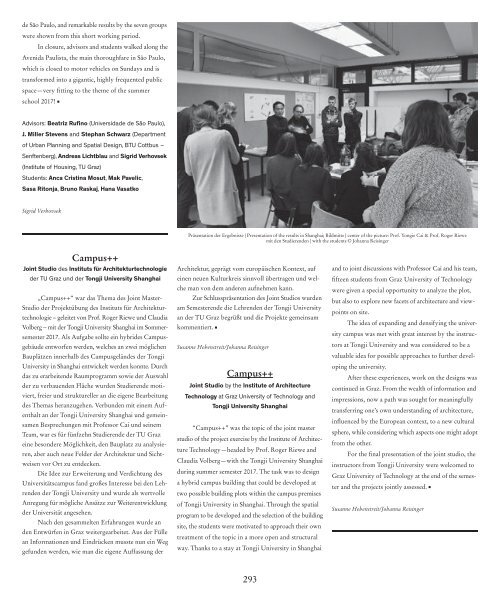Exhibiting Matters
ISBN 978-3-86859-854-4
ISBN 978-3-86859-854-4
You also want an ePaper? Increase the reach of your titles
YUMPU automatically turns print PDFs into web optimized ePapers that Google loves.
de São Paulo, and remarkable results by the seven groups<br />
were shown from this short working period.<br />
In closure, advisors and students walked along the<br />
Avenida Paulista, the main thoroughfare in São Paulo,<br />
which is closed to motor vehicles on Sundays and is<br />
transformed into a gigantic, highly frequented public<br />
space—very fitting to the theme of the summer<br />
school 2017! ■<br />
Advisors: Beatriz Rufino (Universidade de São Paulo),<br />
J. Miller Stevens and Stephan Schwarz (Department<br />
of Urban Planning and Spatial Design, BTU Cottbus –<br />
Senftenberg), Andreas Lichtblau and Sigrid Verhovsek<br />
(Institute of Housing, TU Graz)<br />
Students: Anca Cristina Mosut, Mak Pavelic,<br />
Sasa Ritonja, Bruno Raskaj, Hana Vasatko<br />
Sigrid Verhovsek<br />
Präsentation der Ergebnisse | Presentation of the results in Shanghai; Bildmitte | center of the picture: Prof. Yongie Cai & Prof. Roger Riewe<br />
mit den Studierenden | with the students © Johanna Reisinger<br />
Campus++<br />
Joint Studio des Instituts für Architekturtechnologie<br />
der TU Graz und der Tongji University Shanghai<br />
„Campus++“ war das Thema des Joint Master-<br />
Studio der Projektübung des Instituts für Architekturtechnologie<br />
– geleitet von Prof. Roger Riewe und Claudia<br />
Volberg – mit der Tongji University Shanghai im Sommersemester<br />
2017. Als Aufgabe sollte ein hybrides Campusgebäude<br />
entworfen werden, welches an zwei möglichen<br />
Bauplätzen innerhalb des Campusgeländes der Tongji<br />
University in Shanghai entwickelt werden konnte. Durch<br />
das zu erarbeitende Raumprogramm sowie der Auswahl<br />
der zu verbauenden Fläche wurden Studierende motiviert,<br />
freier und struktureller an die eigene Bearbeitung<br />
des Themas heranzugehen. Verbunden mit einem Aufenthalt<br />
an der Tongji University Shanghai und gemeinsamen<br />
Besprechungen mit Professor Cai und seinem<br />
Team, war es für fünfzehn Studierende der TU Graz<br />
eine besondere Möglichkeit, den Bauplatz zu analysieren,<br />
aber auch neue Felder der Architektur und Sichtweisen<br />
vor Ort zu entdecken.<br />
Die Idee zur Erweiterung und Verdichtung des<br />
Universitätscampus fand großes Interesse bei den Lehrenden<br />
der Tongji University und wurde als wertvolle<br />
Anregung für mögliche Ansätze zur Weiterentwicklung<br />
der Universität angesehen.<br />
Nach den gesammelten Erfahrungen wurde an<br />
den Entwürfen in Graz weitergearbeitet. Aus der Fülle<br />
an Informationen und Eindrücken musste nun ein Weg<br />
gefunden werden, wie man die eigene Auffassung der<br />
Architektur, geprägt vom europäischen Kontext, auf<br />
einen neuen Kulturkreis sinnvoll übertragen und welche<br />
man von dem anderen aufnehmen kann.<br />
Zur Schlusspräsentation des Joint Studios wurden<br />
am Semesterende die Lehrenden der Tongji University<br />
an der TU Graz begrüßt und die Projekte gemeinsam<br />
kommentiert. ■<br />
Susanne Hebenstreit/Johanna Reisinger<br />
Campus++<br />
Joint Studio by the Institute of Architecture<br />
Technology at Graz University of Technology and<br />
Tongji University Shanghai<br />
“Campus++” was the topic of the joint master<br />
studio of the project exercise by the Institute of Architecture<br />
Technology—headed by Prof. Roger Riewe and<br />
Claudia Volberg—with the Tongji University Shanghai<br />
during summer semester 2017. The task was to design<br />
a hybrid campus building that could be developed at<br />
two possible building plots within the campus premises<br />
of Tongji University in Shanghai. Through the spatial<br />
program to be developed and the selection of the building<br />
site, the students were motivated to approach their own<br />
treatment of the topic in a more open and structural<br />
way. Thanks to a stay at Tongji University in Shanghai<br />
and to joint discussions with Professor Cai and his team,<br />
fifteen students from Graz University of Technology<br />
were given a special opportunity to analyze the plot,<br />
but also to explore new facets of architecture and viewpoints<br />
on site.<br />
The idea of expanding and densifying the university<br />
campus was met with great interest by the instructors<br />
at Tongji University and was considered to be a<br />
valuable idea for possible approaches to further developing<br />
the university.<br />
After these experiences, work on the designs was<br />
continued in Graz. From the wealth of information and<br />
impressions, now a path was sought for meaningfully<br />
transferring one’s own understanding of architecture,<br />
influenced by the European context, to a new cultural<br />
sphere, while considering which aspects one might adopt<br />
from the other.<br />
For the final presentation of the joint studio, the<br />
instructors from Tongji University were welcomed to<br />
Graz University of Technology at the end of the semester<br />
and the projects jointly assessed. ■<br />
Susanne Hebenstreit/Johanna Reisinger<br />
293


















